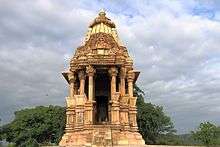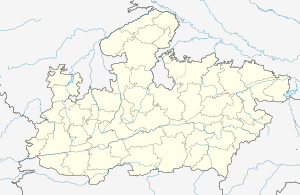Chaturbhuj Temple (Khajuraho)
Chaturbhuj temple (Devanagri: चतुर्भुज मंदिर) is dedicated to Lord Vishnu.[1] The name Chaturbhuj (Devanagri: चतुर्भुज) is a derived from Sanskrit words चतु: = four and भुजा = arms, which literally means One who has four arms; and refers to Lord Vishnu.
| Chaturbhuj Temple | |
|---|---|
 Chaturbhuj temple at Khajuraho | |
| Religion | |
| Affiliation | Hinduism |
| District | Chattarpur, Khajuraho[1] |
| Deity | Vishnu[1] |
| Location | |
| Location | Khajuraho[1] |
| State | Madhya Pradesh |
| Country | India |
 Location in Madhya Pradesh | |
| Geographic coordinates | 24°51′11″N 79°55′10″E |
| Architecture | |
| Creator | Chandella Rulers |
| Completed | Date-able to C. E. 1100 A.D.[1] |
| Temple(s) | 1 |
The temple is Date-able to CIRCA 1100 A.D.[1] This temple is also known as Jatakari[1] (Devanagri:जटकारी) Temple on the name of the village Jatakari[1] (Devanagri:जटकारी), where it is located.
This is the only temple in Khajuraho which lacks erotic sculptures.[1]
Yasovarman of the Chandela Dynasty built the temple at Khajuraho. The temple contains an image of Vishnu.[2]:22
Location
This temple is located near a village Jatakara at Khajuraho.[1] This temple is also known as Jatakari[1] Temple on the name of the village.
It is grouped under southern group of temples, due to is location in southern area of Khajuraho.
Architecture
The temple consists of a sanctum without ambulatory, vestibule,[1] mandapa[1] and an entrance porch.[1] The temple stands on a Modest (chabutara).
Around the wall, there are three bands[1] of sculptures (see also image of outer wall).
Main idol
The main idol in the temple is of four-armed Lord Vishnu (also seen in the image). It is 2.7 meters[1] in height. This idol is south faced as the favorite location of lord Vishnu, same south facing plan is incorporated in Angkor Wat Temple in Cambodia.
Gallery
- Chaturbhuj Temple, Khajuraho India
- Main Idol (Vishnu), Chaturbhuj Temple, Khajuraho India
- Roof, Chaturbhuj Temple, Khajuraho India
- Ganga-Yamuna Sculpture Chaturbhuj Temple, Khajuraho India
- Ganga-Yamuna Sculpture Chaturbhuj Temple, Khajuraho India
- Outer Wall, Chaturbhuj Temple, Khajuraho India
- Shiva Sculpture on Outer Wall, Chaturbhuj Temple, Khajuraho India
References
- "Archaeological Survey of India (ASI) - Chaturbhuj Temple". Archaeological Survey of India (ASI). Retrieved 21 March 2012.
- Sen, S.N., 2013, A Textbook of Medieval Indian History, Delhi: Primus Books, ISBN 9789380607344
External links
- M.P. Tourism Website, Official Website of Madhya Pradesh State Tourism Corporation, Khajuraho
- Archaeological Survey of India, Bhopal Division, Index Page for Khajuraho - Chhatarpur
- Archaeological Survey of India, Bhopal Division, Chaturbhuj Temple, Khajuraho
| Wikimedia Commons has media related to Chaturbhuj Temple Khajuraho. |
